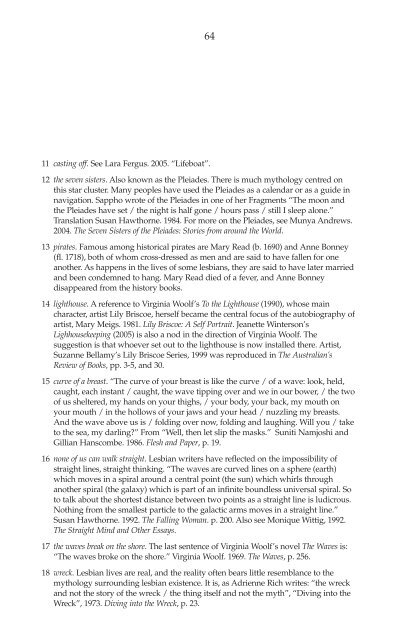Butterfly Effect - ressourcesfeministes
Butterfly Effect - ressourcesfeministes
Butterfly Effect - ressourcesfeministes
Create successful ePaper yourself
Turn your PDF publications into a flip-book with our unique Google optimized e-Paper software.
64<br />
11 casting off. See Lara Fergus. 2005. “Lifeboat”.<br />
12 the seven sisters. Also known as the Pleiades. There is much mythology centred on<br />
this star cluster. Many peoples have used the Pleiades as a calendar or as a guide in<br />
navigation. Sappho wrote of the Pleiades in one of her Fragments “The moon and<br />
the Pleiades have set / the night is half gone / hours pass / still I sleep alone.”<br />
Translation Susan Hawthorne. 1984. For more on the Pleiades, see Munya Andrews.<br />
2004. The Seven Sisters of the Pleiades: Stories from around the World.<br />
13 pirates. Famous among historical pirates are Mary Read (b. 1690) and Anne Bonney<br />
(fl. 1718), both of whom cross-dressed as men and are said to have fallen for one<br />
another. As happens in the lives of some lesbians, they are said to have later married<br />
and been condemned to hang. Mary Read died of a fever, and Anne Bonney<br />
disappeared from the history books.<br />
14 lighthouse. A reference to Virginia Woolf’s To the Lighthouse (1990), whose main<br />
character, artist Lily Briscoe, herself became the central focus of the autobiography of<br />
artist, Mary Meigs. 1981. Lily Briscoe: A Self Portrait. Jeanette Winterson’s<br />
Lighhousekeeping (2005) is also a nod in the direction of Virginia Woolf. The<br />
suggestion is that whoever set out to the lighthouse is now installed there. Artist,<br />
Suzanne Bellamy’s Lily Briscoe Series, 1999 was reproduced in The Australian’s<br />
Review of Books, pp. 3-5, and 30.<br />
15 curve of a breast. “The curve of your breast is like the curve / of a wave: look, held,<br />
caught, each instant / caught, the wave tipping over and we in our bower, / the two<br />
of us sheltered, my hands on your thighs, / your body, your back, my mouth on<br />
your mouth / in the hollows of your jaws and your head / nuzzling my breasts.<br />
And the wave above us is / folding over now, folding and laughing. Will you / take<br />
to the sea, my darling” From “Well, then let slip the masks.” Suniti Namjoshi and<br />
Gillian Hanscombe. 1986. Flesh and Paper, p. 19.<br />
16 none of us can walk straight. Lesbian writers have reflected on the impossibility of<br />
straight lines, straight thinking. “The waves are curved lines on a sphere (earth)<br />
which moves in a spiral around a central point (the sun) which whirls through<br />
another spiral (the galaxy) which is part of an infinite boundless universal spiral. So<br />
to talk about the shortest distance between two points as a straight line is ludicrous.<br />
Nothing from the smallest particle to the galactic arms moves in a straight line.”<br />
Susan Hawthorne. 1992. The Falling Woman. p. 200. Also see Monique Wittig, 1992.<br />
The Straight Mind and Other Essays.<br />
17 the waves break on the shore. The last sentence of Virginia Woolf’s novel The Waves is:<br />
“The waves broke on the shore.” Virginia Woolf. 1969. The Waves, p. 256.<br />
18 wreck. Lesbian lives are real, and the reality often bears little resemblance to the<br />
mythology surrounding lesbian existence. It is, as Adrienne Rich writes: “the wreck<br />
and not the story of the wreck / the thing itself and not the myth”, “Diving into the<br />
Wreck”, 1973. Diving into the Wreck, p. 23.

















